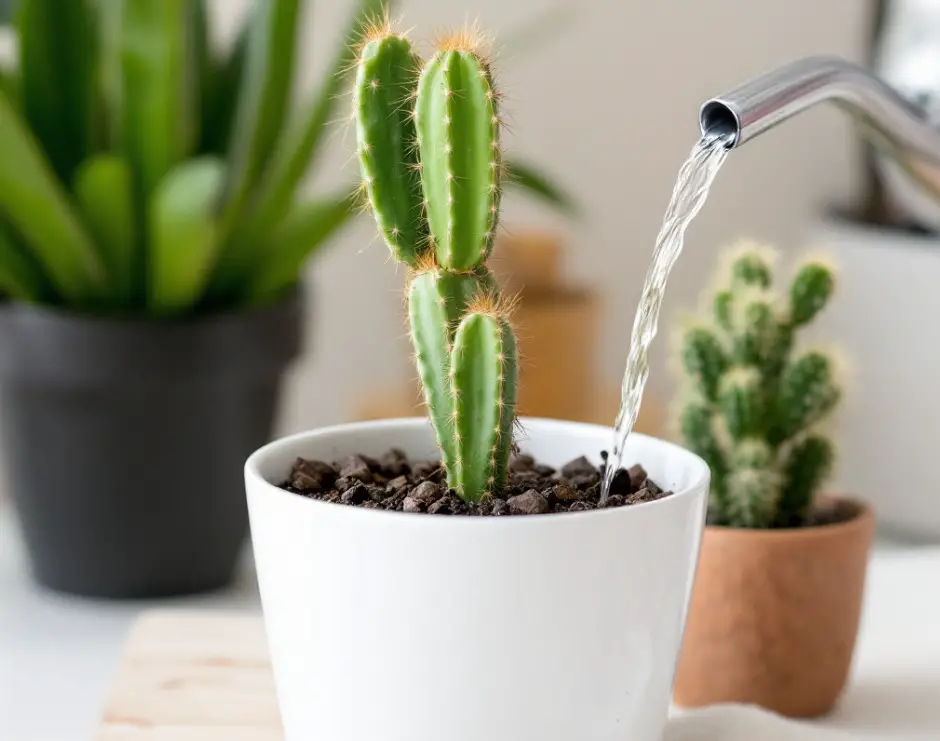Cactus plants are popular among gardeners and indoor plant lovers because of their unique appearance and low maintenance needs. However, one of the most common challenges when growing cacti is figuring out how often you should water a cactus to avoid overwatering. Overwatering is the number one cause of cactus death, and understanding the right watering schedule is key to keeping your cactus healthy.
Knowing the balance between watering enough to keep your cactus alive and not watering so much that you harm it can be tricky. Each cactus species, environment, and potting situation affects how often you should water. Paying attention to signs from your cactus and the conditions it lives in helps you find the best watering routine.
This guide will explain everything about watering cacti, how to recognize overwatering, and how often you should water to keep your cactus thriving. With the right knowledge, you can enjoy your cactus plants for many years.
Understanding Cactus Water Needs

Why Do Cacti Require Less Water?
Cacti are desert plants adapted to survive in arid environments with very little rainfall. Their thick, fleshy stems store water for long periods, allowing them to survive droughts. Unlike many other plants, cacti have a slow metabolism and low water demand, meaning they only need occasional watering.
Because of these adaptations, cacti do not thrive with frequent watering. Their roots can easily rot if left in consistently wet soil. Understanding this natural water conservation ability helps gardeners avoid the mistake of overwatering.
Factors Influencing How Often to Water a Cactus
The ideal watering frequency for a cactus depends on several factors including the species of cactus, the climate and environment, the season, the pot size and type, and the soil composition. Each of these elements changes how quickly water evaporates from the soil and how much moisture your cactus retains.
For example, cacti grown indoors in cooler or more humid environments need less water than those grown outdoors in hot, dry conditions. Similarly, small pots dry out more quickly than large ones, and sandy soil dries faster than rich, loamy soil.
Taking all these into account allows you to create a watering schedule that supports healthy cactus growth without risking overwatering.
Signs of Overwatering a Cactus
How to Identify Overwatered Cacti
Overwatering can be fatal to cacti because it causes root rot and fungal infections. Early detection of overwatering signs is crucial to saving your plant. Common symptoms include soft, mushy stems, yellow or brown discoloration, a drooping appearance, a sour smell coming from the soil, or blackened roots near the base.
If your cactus feels unusually soft or you notice a change in color or texture, it may already be suffering from excess moisture. In severe cases, overwatering can lead to complete plant collapse or irreversible damage to the root system.
Catching these signs early gives you a chance to act quickly and potentially save the plant.
Difference Between Overwatering and Underwatering
Sometimes symptoms of overwatering and underwatering can look similar, such as shriveling or yellowing. However, underwatered cacti typically have dry, wrinkled skin and may be lighter in weight. Overwatered plants feel soft and may have discolored, soggy tissue.
Understanding these differences helps you respond appropriately to your cactus’s needs. While an underwatered cactus can recover quickly with a good soak, an overwatered one often requires trimming and repotting to survive.
How Often Should You Water a Cactus?
General Watering Guidelines
While watering needs vary, a good rule of thumb for most cacti is to water deeply but infrequently. During the growing season, watering every two to four weeks is often sufficient. The key is to allow the soil to dry out completely between watering sessions.
In the dormant season, which usually spans fall and winter, watering should be drastically reduced or stopped altogether. Some gardeners water only once a month or even less during this time to mimic natural dry conditions.
Overwatering during the dormant season is one of the most common mistakes and should be avoided by carefully monitoring soil dryness before each watering.
Adjusting Watering Frequency Based on Environment
If your cactus is kept indoors, it generally requires less frequent watering due to controlled temperature and humidity. Conversely, outdoor cacti in hot, dry climates may need watering every one to two weeks depending on the intensity of heat and wind.
Temperature and sunlight exposure also affect evaporation rates from soil and water needs. Hotter, sunnier spots dry soil faster, meaning you might need to water more often than in cooler, shaded areas.
If you’ve recently moved your cactus to a new location, monitor it closely for signs of stress or changes in water needs.
Testing Soil Moisture Before Watering
One effective method to avoid overwatering is to test the soil moisture before watering. Stick your finger about an inch into the soil. If it feels dry, it’s time to water; if it still feels moist, wait a few more days and check again.
Alternatively, using a moisture meter designed for potted plants can give you a precise reading of soil moisture levels. This tool is particularly helpful if you’re new to cactus care or caring for multiple varieties at once.
Monitoring soil instead of following a fixed schedule is the best way to prevent accidental overwatering.
Best Practices for Watering Cacti
Watering Technique
When watering, it’s important to saturate the soil thoroughly so that water reaches the entire root system. Avoid sprinkling water lightly on the surface, as this can encourage shallow roots and fungal growth.
Water the cactus until you see excess draining out of the pot’s drainage holes. This ensures the soil is evenly moist without waterlogging. After watering, allow the soil to dry out completely before watering again.
Avoid watering from the top where water can collect in the crown, especially for varieties like Echinopsis or Mammillaria. Standing water in the crown can cause rot.
Choosing the Right Pot and Soil
Using pots with drainage holes is crucial to prevent water from pooling at the bottom. Cacti need well-draining soil mixes, usually composed of sand, perlite, and organic material.
Avoid heavy garden soil or potting mixes that retain too much moisture. The right soil and pot combination helps maintain optimal moisture and reduces the risk of overwatering.
Repotting your cactus every couple of years with fresh soil also improves drainage and keeps roots healthy.
Seasonal Watering Adjustments
During spring and summer, cacti are actively growing and need more frequent watering. In fall and winter, when growth slows or stops, watering should be limited.
If your cactus is outdoors and exposed to rain during dormant months, you may not need to water at all. Monitoring weather conditions is part of responsible cactus care.
Always adjust watering to reflect seasonal changes and your plant’s specific behavior during each phase.
Recovering From Overwatering
What to Do If You Overwatered Your Cactus
If you suspect overwatering, the first step is to stop watering immediately. Remove the cactus from its pot and inspect the roots carefully. Healthy roots are firm and white or light tan, while rotten roots will be black, mushy, or smell bad.
Trim off any rotten roots using sterilized scissors or pruning shears. Allow the plant to dry for a day or two in a shaded, airy spot.
This drying period gives the cactus a chance to recover and reduces the risk of further fungal infection before repotting.
Repotting With Fresh Soil
After trimming, repot the cactus in fresh, dry, well-draining soil. Choose a pot with drainage holes and avoid watering for a week or two to let the roots recover.
This recovery period helps prevent further rot and encourages new root growth. Keep the plant in a bright but indirect light location during recovery to minimize stress.
If the damage was caught early, most cacti bounce back well after repotting and careful aftercare.
Preventing Future Overwatering
Adjust your watering schedule based on how quickly the soil dries out and the plant’s health. Consider using cactus-specific soil mixes and ensure your pot has proper drainage.
Avoid using decorative pots without holes unless you place a plastic nursery pot inside that drains properly. Regularly feel the soil or use a moisture meter to avoid guesswork.
Remember, it’s better to underwater slightly than to overwater when it comes to cacti.
Common Myths About Watering Cacti
Myth: Cacti Don’t Need Water at All
While cacti are drought-tolerant, they do need water to grow and survive. They store water in their tissues but still require occasional watering, especially during the growing season.
Neglecting to water at all can result in slow growth, shriveling, and long-term health decline.
Myth: You Should Water Cacti Every Day
Watering cacti daily is a sure way to cause root rot and kill your plant. Their natural habitat involves long dry periods, so watering should mimic those cycles.
Healthy cactus care is built on patience and attentiveness, not frequent watering.
Myth: The Smaller the Pot, the More Water Needed
Although smaller pots dry faster, overwatering remains a risk. It’s important to check soil moisture rather than follow a fixed watering schedule based on pot size alone.
Every cactus, regardless of pot size, should only be watered when the soil is fully dry.
FAQ About How Often Should You Water a Cactus
How often should I water my cactus indoors?
Indoor cacti generally need watering every 2 to 4 weeks during the growing season. Always check that the soil is completely dry before watering again. In winter, many indoor cacti only need water once a month or even less.
Do all cactus species need the same watering schedule?
No. Different cactus species have different water requirements. Desert cacti need very little water, while tropical cacti like Christmas cactus may need slightly more frequent watering, especially when blooming.
What happens if I water my cactus too often?
Overwatering can lead to root rot, soft stems, yellowing, and eventually plant death. Cacti are very sensitive to moisture buildup, so it’s important to let the soil dry completely between waterings.
How do I know when my cactus needs water?
The best way is to feel the soil about an inch below the surface. If it feels dry, it’s time to water. Also, a cactus that looks slightly shriveled or lighter in weight may need hydration—but always confirm with the soil.
Should I water my cactus differently in summer and winter?
Yes. In summer, during active growth, cacti need more frequent watering. In winter, most cacti go dormant and require very little to no water. Adjust watering based on the season and your local climate.
Is misting a cactus a good idea?
No, misting is not necessary for most cacti and can increase the risk of fungal issues. Cacti prefer deep, infrequent watering directly into the soil rather than moisture on their surface.
Can I use tap water to water my cactus?
Tap water is usually fine, but if your water is very hard or high in minerals, it can build up in the soil. Rainwater or filtered water is a better choice, especially for long-term health.
Conclusion: How Often Should You Water a Cactus to Avoid Overwatering?
Finding the perfect watering balance is essential for growing healthy cacti. Knowing how often you should water a cactus to avoid overwatering depends on understanding your plant’s species, environment, and growth cycle.
Most cacti do best when watered deeply but infrequently, allowing soil to dry out completely between watering. Adjust watering frequency with the seasons and always check soil moisture before watering again.
By following these guidelines and observing your cactus carefully, you can prevent overwatering, avoid root rot, and enjoy a thriving cactus collection that adds beauty and character to your space.






